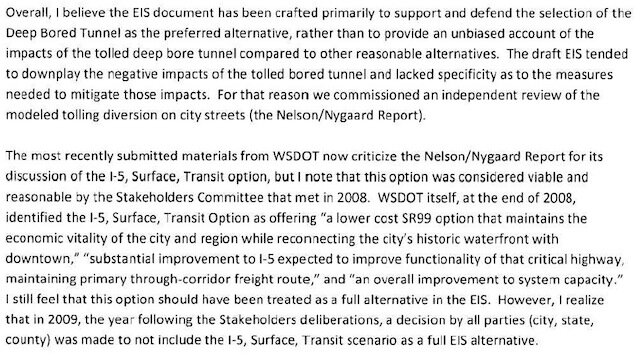There are two substantially different rationales that Washington’s Department of Transportation has advanced for its choice of a new, larger 520 bridge across Lake Washington. First, the existing bridge is unsafe, vulnerable to earthquake and wind. Secondly, the 1963 bridge was designed to carry a maximum of 65,000 vehicles per day, and today carries up to 115,000 (but not speedily.)
While I don’t think anyone is arguing the first point, it’s jarring then to see WSDOT’s projections for the new bridge show vehicle traffic not reaching 100,000 per day again until 2032, and topping out around 118,000 by 2052. This is not to disregard time savings, but at a cost of $4.65 billion, to wonder if there might be a better way of achieving them.
Why would so much traffic divert? Tolls. As Mike Lindblom reports for the Seattle Times, WSDOT’s financial projections call for some 48 percent of existing traffic to seek other routes, thanks to $3.50 Good to Go tolls on the bridge during peak hours (that’s $5.00 if you haven’t signed up with Good to Go). The tolls are supposed to increase 2.5 percent annually until 2017, at which time they will increase 15 percent.
WSDOT has to be hard-nosed with these projections, which differ from previous estimates, because they are being used to secure investment funding. It makes sense for them to reassure conservative investors by saying, essentially, “Look, even if only half the people who currently use the bridge pay the tolls, we still raise enough money to pay you back.” (Mention of Tim Eyman’s Initiative 1125, which would likely sink tolling plans completely is absent from the financial study.)
That said, as they define the space of possibility to include such a drastic diversion, it does make you wonder what the bridge-driving taxpayers’ return on investment will be.
As every story on the bridge’s construction will tell you, $4.65 billion is so much money that the project is still missing $2 billion. Back in 2010, the Legislature authorized funding of up to $2.62 billion for the 6-lane bridge, and a 6-lane connector to I-405 at its east end. The bridge is supposed to open in 2014.
Seattlepi.com summarizes the incremental-build result for you: “That means a six lane bridge would link up with the same four-lane configuration that exists now between the lake and I-5, which some fear will only add to bottlenecks west of the shoreline.” (“Some,” I think in this case means anyone who has spent more than five minutes thinking about it.)
People in that latter group are the Coalition for a Sustainable 520, and their attorney David Bricklin. The group filed suit in U.S. District Court in Seattle on September 2, naming WSDOT and the Federal Highway Administration, and declaring that the project’s Final Environmental Impact Statement includes:
…a failure to include all reasonable alternatives in detail; a failure to adequately describe the existing environment; a failure to adequately describe the significant adverse environmental impacts of the project; a failure to adequately analyze measures to mitigates the project’s significant adverse environmental impacts; and a failure to describe the project’s unavoidable significant adverse environmental impacts.
An email from the group adds:
The state has applied for shoreline permits for the entire 520 project, not just the partial bridge that has been approved for construction. These permits cover the areas near us: Portage Bay, Union Bay, the Montlake cut area, and near Madison Park/Laurelhurst. In general, the state plans to harm these areas, and to provide compensating mitigation further away…on the Cedar River, in Magnuson Park, uplands near Union Bay.
We believe that the environment near us should not be damaged this way. It is already quite stressed enough, and further stresses could tip it over the edge. So we want mitigation to be right in the area.

